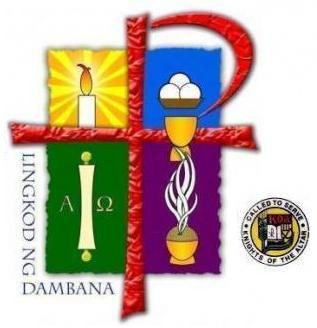|
The Liturgical Formations that a Knights of trhe
Altar should know.
Liturgical Vestments

|
When vesting for the liturgy, the cleric
first
washes his hands, praying: |
|
|
Give virtue to my hands, O Lord, that being cleansed from all stain I might serve you with purity of mind and body.
|
|
|
Then he puts on his: |
|
|
Amice
Symbol of the helmet of salvation
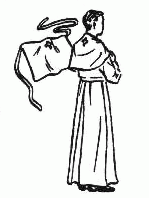
The amice is a rectangular piece of white linen
with two strings at the upper corners which a cleric uses underneath his alb to cover the neck so that the Roman collar of
the cassock is hidden. The word amice comes from the Latin amicire, meaning "to cover" and, because the heads of criminals
condemned to death were covered in linen, the amice recalls the humiliation which was put upon Christ. As he puts on the amice,
the priest kisses the Cross on the Amice and prays:
Place upon me, O Lord, the helmet of salvation, that
I may overcome the assaults of the devil.
|
|
|
|
Alb
Symbol
of purity
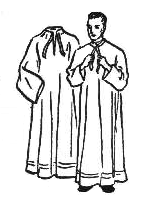
The alb is the long white, robe-like
vestment worn by all clerics at liturgical celebrations (celebrant, concelebrant, deacon, or acolyte). The alb (from Latin
word alba, meaning "white") can be traced to the ancient Roman alb worn under a cloak or tunic; its color symbolizes
purity and its form recalls that described in Ezekiel 28:4. As he puts on his alb, he prays:
Purify me, O Lord, and cleanse my heart; that, being
made white in the Blood of the Lamb, I may come to eternal joy.
|
|
|
|
Cincture
Symbol
of Chastity
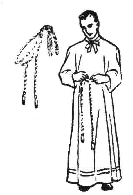
The cincture ties the alb at the waist. As he ties it, he
prays:
Gird me, O Lord, with the girdle of purity, and extinguish
in me all evil desires, that the virtue of chastity may abide in me.
|
|
|
|
Maniple
Symbol
of the acceptance of suffering

The maniple is a narrow strip of linen,
of the same color as the chasuble, suspended from the left forearm so that if falls equally on both sides of the arm. It is
to remind the cleric that he must patiently bear the cares and sorrows of this earthly life in the service of God and for
Heavenly reward. Bishop puts on the maniple at the Altar after the Confiteor; other clerics put it on in the sacristy before
the service. As the cleric puts on the maniple, he kisses the Cross on the maniple and prays:
Grant, O Lord, that I may so bear the maniple
of weeping and sorrow, that I may receive the reward for my labors with rejoicing.
|
|
|
|
Stole
Symbol of the clerical office,
immortality, and the yoke of Christ
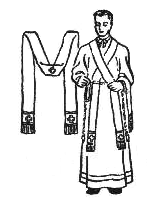
The stole, matching the liturgical color,
is a long, scarf-like vestment worn over the alb and under the dalmatic/chasuble. The priest wears the stole around his neck
so that it hangs equally down his chest in front or forms an X-shaped Cross; the deacon wears his stole over the left shoulder
and tied at his right side; the Bishop wears his stole so that it hangs equally down his chest. As he puts on the stole, the
priest kisses the Cross on the stole and prays:
Restore unto me, O Lord, the stole of immortality,
which was lost through the guilt of our first parents: and, although I am unworthy to approach Your sacred Mysteries, nevertheless
grant unto me eternal joy.
|
|
|
|
Chasuble or Cope

For the Eucharistic Liturgy: Chasuble
The
chasuble, also matching the liturgical color, is is the long, often ornate, sleeveless poncho-like garment worn by priests
and bishops over the alb and stole during the sacrifice of the Mass. As he puts on the chasuble, he prays:
O Lord, Who said: My yoke is easy and My burden light:
grant that I may bear it well and follow after You with thanksgiving. Amen.
For non-Eucharistic Liturgy: Cope
The
cope is a large mantle worn by clerics (including deacons) at some liturgical celebrations (but not at the Mass) -- for example,
during Processions and Benedictions of the Blessed Sacrament. It matches the color of the liturgy and is worn in the same
way as the chasuble or dalmatic.
Deacon
for the Eucharistic Liturgy: Dalmatic
Instead of a chasuble like a priest wears, the deacon wears the sleeved dalmatic,
also matching the liturgical color, over his alb and stole. Bishops also wear a dalmatic at major solemn feasts and ordinations.
It symbolizes charity, justice, and the sufferings of Christ. As he puts on the dalmatic, the deacon or bishop prays:
Lord, endow me with the garment of salvation,
the vestment of joy, and with the dalmatic of justice ever encompass me.
Biretta
The biretta is a tri-cornered or square-shaped hat with silk
trim, tuft (except for the birette of seminarians and cardinals) and three raised wings, called "horns," on top at three corners
(the side of the hat without the horn is worn on the left side of the head). It is made of scarlet silk for cardinals, violet
silk for bishops, and black merlino for priests, deacons, and seminarians.
|
|
|
In addition to the above,
the Bishop wears
a: |
|
|
Pectoral Cross
The pectoral cross is a cross, usually about 6
inches in height, worn around the neck of a bishop and suspended by either cord (in liturgical vestments or choir) or chain
(in abito piano). The cord is scarlet and gold for a cardinal; green and gold for a bishop. The pectoral cross is worn
on the chest of prelates so as to keep the Cross close to their hearts.
Crozier
The crozier is the shepherd's staff used by bishops. The crozier
has always been in the Church a symbol of the bishop's pastoral role. In the very early Church, it was made of wood, but in
the early Middle Ages metal (silver and gold, depending on rank) was used instead. Wooden croziers again began to be used
during the time of Vatican II and are common today.
Popes don't use a crozier, and only since the time of Vatican
II have they used a crozier-like staff called the "pastoral staff." The pastoral staff is silver with a crucifix at the top.
Episcopal Ring
When a Bishop is consecrated as Bishop, he receives a ring
representing his office (Cardinals receive their own special ring, also). The Pope's ring, known as the "Fisherman's Ring,"
is the personal and unique seal of that reigning Pontiff and is (or at least used to be) destroyed on his death.
Zucchetto
The zucchetto is the silk yarmulka-like skullcap worn by bishops.
The Pope's zucchetto is white; the cardinals' zucchetti are scarlet; the bishops' zucchetti are violet. Priests may use a
black cloth zucchetto for everyday wear, but not during the liturgy.
Mitre
The mitre imitates the Old Testament priestly headcovering
and is the headdress of bishops, worn at liturgical functions. It is either precious, golden (orphreyed), or simple (simplex).
The precious mitre is worn by celebrants, the simple by concelebrants, and the golden by the celebrant at an ordination. All
cardinals wear a damasked mitre (simplex) in presence of the Pope. It is very tall and made of layered white damask silk.
|
|
|
In addition to the above,
a Metropolitan
(Archbishop) wears a: |
|
|
Pallium
The pallium is worn only by archbishops (in their own
dioceses), patriarchs, and the Pope, as symbol of their authority. It's a band of white wool adorned with 6 small black crosses,
worn around the neck with extensions front and back, and pinned to the chasuble in three places about the neck. The non-silk
part of the pallium is made of white wool, part of which is supplied by two lambs presented annually by the Lateran Canons
Regular on the feast of St. Agnes (21 January). The lambs are solemnly blessed on the high altar of that church after the
pontifical Mass, and then offered to the pope, who sends palliums made of their wool to the archbishops.
|
|
|
In addition to the above, the Pope wears a: |
|
|
Fanon
The fanon is a vestment , rarely used nowadays,
reserved for the Pope during a pontifical Mass. It consists of a double mozzetta (short shoulder-cape worn by bishops outside
the liturgy), the first going under the stole and the second over the chasuble. |
|
|
 |
|
Liturgical Vessels
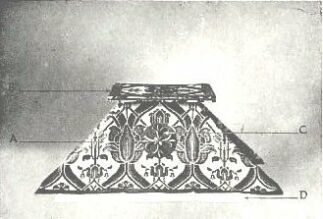 |
 |
A: Chalice Veil which covers the Chalice underneath
B:
Burse
C: Cross on front of veil
D: Corporal on which the veiled Chalice sits | |
E: Chalice
F: Paten
G: Purificator
H:
Corporal |
|
I: Ciborium
J: Folded Chalice Veil
K: Pall
L:
Burse | |
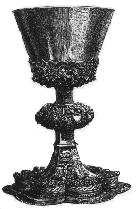 |
Chalice
The consecrated gold or
gilded silver cup used to hold the Precious Blood. Only priests or deacons are allowed to touch the Chalice (though sacristans
may in the course of their duties). Pewter Chalices are "okay" for use during times of persecution but, even then, the inside
of the bowl must be gilded.
When Mass begins, the Chalice is covered by the folded purificator and the pall (see below). |
|
|

|
Paten
The consecrated gold or
gilded silver plate on which the Sacred Host is laid. Only priests or deacons are allowed to touch the Paten (though sacristans
may in the course of their duties). A Communion Paten has a handle and is held under the chin of one receiving the Eucharist
so that in case the Host is dropped, it won't fall to the floor. |
|
|

|
Ciborium
A chalice-shaped vessel
with a lid used to hold consecrated Hosts for distribution during the Communion of the faithful. It can be made of any
material as long as the inside is gilded. It is kept in the Tabernacle between Masses, covered with a white veil (which can
be decorated with precious metals). |
|
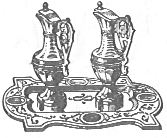 |
Cruets
These vessels hold the
water and wine before Consecration |
|
|

|
Monstrance (or "Ostensorium" or "Ostensory")
A
gold or silver vessel, often in a sunburst shape, with a clear glass area, called a "luna," for viewing the Sacrament. The
Host is kept in place inside the crystal or glass frame by a crescent shaped gold or silver gilded clip called a "lunette."
The monstrance is used during Benedictions and processions, etc., for adoration by the faithful. It doesn't require a blessing,
but it should be blessed.
|
|
 |
Aspersory and Aspergillium (or "Aspergill")
The
Aspersory is a container for holding Holy Water. The Aspergillium is a stick-shaped implement with holes in it to dip into the Aspersory and catch the
Holy Water for sprinkling the people and things. |
|
|

|
Thurible (or "Censer") and Boat
A
thurible is the incense burner used at Mass. It hangs from chains so it can be swung to incense people and things. The boat is
where the incense is stored until it is placed in the thurbible. |
|
|

|
Pyx
A small container,
also called a custodia, used to carry the Sacred Host when taking it to the sick and homebound. It is made of the same material
as the Ciborium -- gilt on the inside.
|
|
|
Altar Linens |
|
|
Chalice veil
Small silk cloth,
of the same color as the priest's vestments, used to cover the Chalice |
|
|
Purificator (or "Mundatory" or "Purificatory")
Rectangular
piece of linen or hemp used to wipe the Chalice before the Offertory and after Communion, the priest's lips and fingers. It
requres no special blessing. |
|
|
Pall
A blessed, stiff square piece
of linen, sometimes decorated with a Cross or other embroidery, used to cover the Chalice to prevent impurities from falling
into it. If it is embroidered or made of silk, the side touching the Chalice must still be made of linen.
Another type
of pall is the cloth used to cover coffins at Requiem Masses. |
|
|
Finger Towels
These may be made
of any material (preferably linen) and are used at the lavabo and after Communion |
|
|
Corporal
A blessed square linen
cloth which is spread out by the priest in the middle of the Altar. From the Catholic Encylopedia, "after it [the corporal]
is washed, bleached, and ironed, it is folded into three equal parts, both in its length and in its width, i.e. the anterior
part is folded over the middle; then the posterior part is turned down over the anterior part; after this the part at the
priest's right is folded over the middle, and finally the part at the priest's left is folded over these. The corporal is
placed in the burse in such a manner that the edge of the last fold is towards the opening of the burse." |
|
|
Burse
A 10-inch square
container to hold the Corporal. The burse covers the chalice before the Mass, with the opening of the burse facing toward
the priest. (The leather pouch used to hold the pyx is also called a burse) |
Liturgical Vessels and Vestments Used at Mass
1. What are vestments?
Vestments are special robes worn to celebrate the Eucharist and the other sacraments. Usually
the priest celebrating Mass wears the alb, stole and chasuble.
2. What is an alb?
The alb is a long white tunic or robe which the priest wears under the chasuble while offering
the Eucharistic Sacrifice.
3. What is a chasuble?
The chasuble is the outer vestment of the priest celebrating Mass. It comes in different colors
and often is decorated with religious symbols.
4. What is a stole?
A stole is a long, narrow band of the same material and color as the chasuble. The priest wears
it around his neck and hanging down in front. The deacon wears it over his left shoulder and drawn across the chest to the
right side, where it is fastened.
5. What is a cincture?
The cincture is a long cord used to gather the alb at the priest's waist.
6. What is a dalmatic?
The dalmatic, a vestment similar to a chasuble, is worn by the deacon over the alb and stole at
liturgical celebrations.
7. What is an altar?
An altar is the table of the Lord, made of marble, granite, wood or another solid, attractive
material. It occupies the central position in the church sanctuary. The People of God are called together to share in the
offering of the Lord Jesus at this altar of sacrifice. Usually, relics of martyrs or saints are put inside the altar. (1383)
8. Why is the crucifix placed on the altar or near it?
The crucifix reminds the worshipping community of Jesus' sacrifice of the cross.
9. What meaning do the lighted candles have?
The lighted candles witness to our devotion to Jesus who is light and life with his grace.
10. What is a lectern?
A lectern is a pulpit from which the Liturgy of the Word is proclaimed.
11. What is a lector?
A lector is the person who proclaims God's Word (other than the Gospel) at Mass.
12. What kind of bread must be used to celebrate the Eucharist?
The bread used to celebrate the Eucharist must be made only of wheat ťour and water. Nothing else
may be substituted or added. (1412)
13. What kind of wine must be used to celebrate the Eucharist?
Pure, natural grape wine must be used to celebrate the Eucharist. Such wine, made for sacramental
purposes, should be clearly designated as altar wine. (1412)
14. What are the cruets?
The cruets are small pitchers containing the wine and water used during the Eucharistic Celebration.
15. What is the chalice?
The chalice is the sacred cup in which the wine becomes the true Blood of Christ at the consecration.
16. What is a ciborium?
A ciborium is a cup with a matching lid, used to hold the Body of Christ that will be given in
Holy Communion.
17. What is a corporal?
A corporal is a piece of linen cloth on which rest the vessels holding the Sacred Species during
Mass.
18. What is a pall?
A pall is a linen card about six inches square, used to cover the
chalice containing the precious Blood.
19. What is a paten?
A paten is the dish upon which the bread, and later, the consecrated Host, is placed.
20. What is a purificator?
A purificator is a small linen towel that the priest uses to cleanse the sacred vessels.
21. What is a finger towel?
A finger towel is another small piece of linen which the priest uses to dry his fingers after
the rite of washing following the preparation of the gifts.
22. What books are used at Mass?
The sacramentary is the book containing the presider's part of the Mass except for the scriptural
readings and psalm responsories, which are printed in a book called the lectionary. A large book of the Gospels may also be
used.
23. In regard to the Mass, what do we mean by the word "option"?
Options are choices the Church permits the priest
|
 |
|
|
 |
|
|
|
